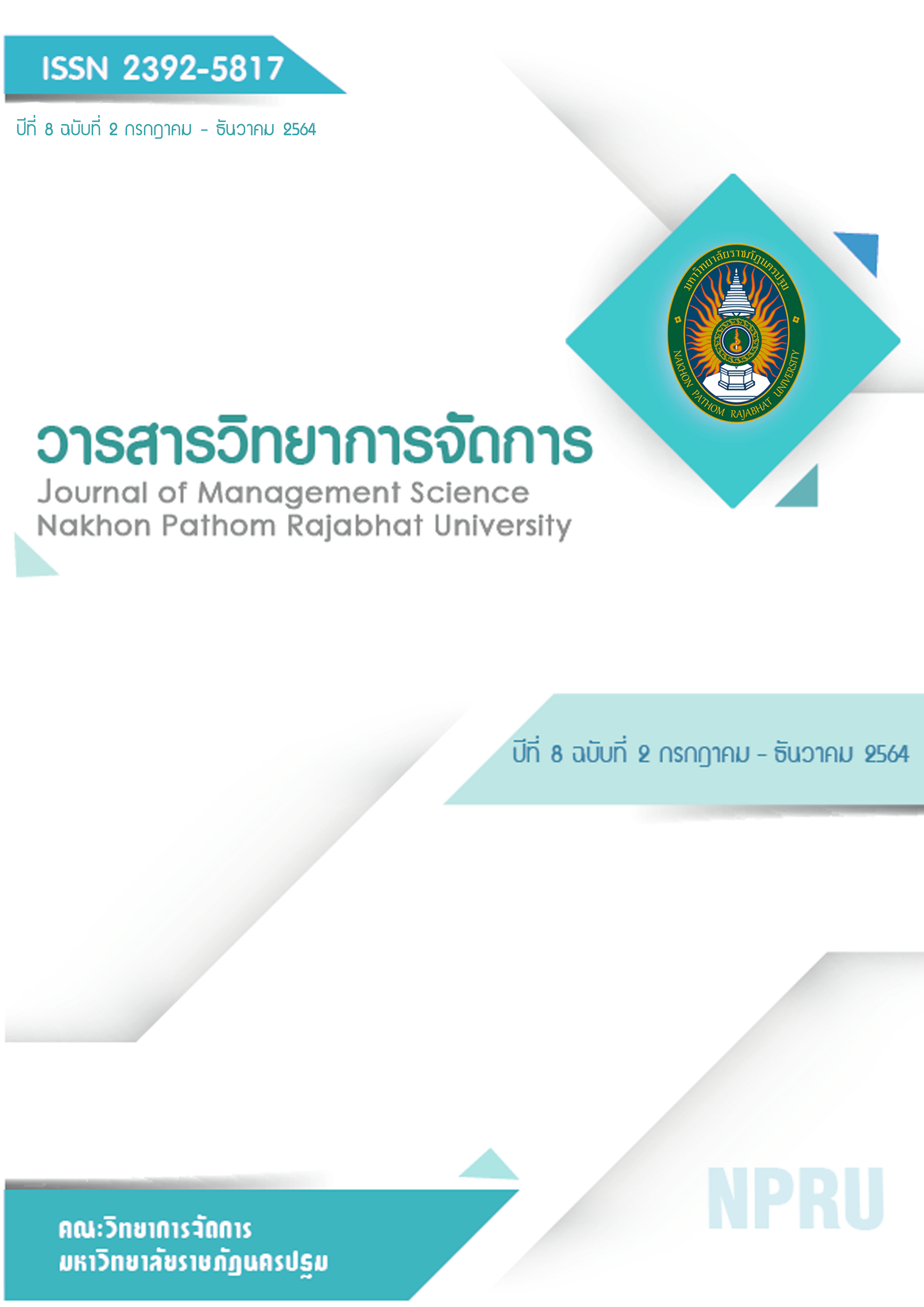Balanced Scorecard Administrative Strategies of A Community Enterprises Group for Processing Product from Coconut, Ampawa District, Samut Songkhram Province
Main Article Content
Abstract
The study was aimed to 1) study the Balanced Scorecard (BSC) administrative strategies of community enterprise groups for processing product from coconut, Ampawa District, Samut Songkhram Province and 2) to present the Balanced Scorecard (BSC) administrative strategies of community enterprise groups for processing product from coconut, Ampawa District, Samut Songkhram Province by using the in-depth interview. The sample group of this study was 24 leaders and members from 4 community enterprise groups; The Learning Center under the Royal Initiative, Shoe-Manufacturing community enterprise group, Traditional Thai Dessert and Coconut Stalk Basketry community enterprise group in Bang Chang and Brown Coconut Stalk Basketry community enterprise group in Tha Ka. All data obtained were analyzed, gathered and concluded for the appropriate guideline.
The findings of the Balanced Scorecard (BSC) administrative strategies of community enterprise groups for processing product from coconut, Ampawa District, Samut Songkhram Province revealed that; 1) Customer Perspective – the target group was not the local customer who traveled and bought it as a souvenir, and the local customer who bought it for the household use as it’s not expensive, 2) Financial Perspective – the annual income rate of the target group of The Learning Center under the Royal Initiative has increased 45,000-80,000 baht as there were a different kind of product, and the annual income rate of other community enterprise groups has increased 15,000-30,000 baht as there was a limit of the product, 3) Internal Process Perspective – it was structured as the community enterprise group leader, board of the community enterprise group and member of the community enterprise group, operated by the chairman, vice chairman and secretary with the undefined role and responsibility, and 4) Learning and Growth Perspective – there was no knowledge of creating value-added product and no new generation for its inheritance.
The findings of the Balanced Scorecard (BSC) administrative strategies of community enterprise groups for processing product from coconut, Ampawa District, Samut Songkhram Province revealed that; 1) Product Development Strategy – to enhance the quality standard, 2) New Product Development Strategy – for more different kind of product, 3) Service Strategy – for more accessibility, 4) Distribution Strategy – to apply the information technology for the local product development, 5) Transportation Strategy – to choose the private transport service for more rapidity, 6) Proactive Public Relation – to choose the appropriate public relation media for the community enterprise product, 7) Proficiency Development Strategy – to improve the human capital for more knowledge, proficiency and expertise on the community enterprise product.
Article history : Received 19 October 2020
Revised 28 January 2021
Accepted 1 February 2021
SIMILARITY INDEX = 2.80 %
Article Details

This work is licensed under a Creative Commons Attribution-NonCommercial-NoDerivatives 4.0 International License.
The views and opinions of the article appearing in this journal are those of the author. It is not considered a view and responsibility of the editorial staff.
References
กรกฎ สระคูพันธ์ และศุภวัฒนากร วงศ์ธนวสุ. (2561). การศึกษาการบริหารจัดการวิสาหกิจชุมชนกลุ่มแปรรูปจากข้าวหอมมะลิ : กรณีศึกษาจังหวัดร้อยเอ็ด. วารสารบัณฑิตศึกษา มหาวิทยาลัยราชภัฎสกลนคร, 16 (74), 14.
จักรพงษ์ นวลชื่น. (2560). แนวทางการพัฒนาวิสาหกิจชุมชนให้ยั่งยืนด้วยภูมิปัญญาท้องถิ่น ศึกษากรณี วิสาหกิจชุมชนในจังหวัดนครพนมและจังหวัดสกลนคร. กรุงเทพฯ : วิทยาลัยป้องกันราชอาณาจักร.
ทรงศักดิ์ ศรีบุญจิตต์ อารี วิบูลย์พงศ์ นันธมน ธีระกุล ประทานทิพย์ กระมล และพิมพิมล แก้วมณี. (2547). การปรับปรุงโครงสร้างอุตสาหกรรมหัตถกรรมพื้นบ้านในภาคเหนือตอนบน. เชียงใหม่ : ศูนย์วิจัยเพื่อเพิ่มผลผลิตทางเกษตร คณะเกษตรศาสตร์และคณะเศรษฐศาสตร์ มหาวิทยาลัยเชียงใหม่.
ภัทรธิดา วัฒนาพรรณกิตติ. (2559). ปัจจัยที่มีผลต่อความสำเร็จของวิสาหกิจชุมชนระดับ 5 ดาว จังหวัด
ลำปาง. วารสารการวิจัยกาสะลองคำ มหาวิทยาลัยราชภัฏเชียงราย, 10 (2), 1-16.
สำนักงานสหกรณ์จังหวัดสมุทรสงคราม. (2563). ข้อมูลกลุ่มอาชีพ/วิสาหกิจชุมชน. [ออนไลน์]. ค้นเมื่อ1 กรกฎาคม 2563 จาก http://webhost.cpd.go.th/samutsongkram/data_3.html
สำนักงานคณะกรรมการพัฒนาการเศรษฐกิจและสังคมแห่งชาติ. (2560). แผนพัฒนาเศรษฐกิจและสังคมแห่งชาติ ฉบับที่ 12 พ.ศ. 2560-2564. กรุงเทพฯ : สำนักนายกรัฐมนตรี.
สำนักงานเลขานุการ คณะกรรมการส่งเสริมวิสาหกิจชุมชน. (2548). พระราชบัญญัติส่งเสริมวิสาหกิจชุมชน พ.ศ.2548. กรุงเทพฯ : กรมส่งเสริมการเกษตร กระทรวงเกษตรและสหกรณ์
สำนักงานเลขานุการ คณะกรรมการส่งเสริมวิสาหกิจชุมชนจังหวัดสมุทรสงคราม. (2562) สรุปผลการดำเนินงานโครงการส่งเสริมและพัฒนาวิสาหกิจชุมชน. กรุงเทพฯ : กรมส่งเสริมการเกษตร
Kaplan, R. S. and Norton D. P. (1996a). The Balanced Scorecard: Translating Strategies into Action. Boston: Harvard Business School Press.
Kaplan, R. S. and Norton D. P.. (1996b). Using the Balanced Scorecard as Strategic Management System. Boston: Harvard Business School Press.


